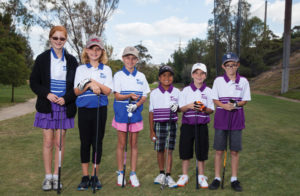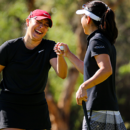Golf’s Little Leagues: PGA Junior League is Exposing Kids to a New Form of Team Golf

The kids didn’t march behind team banners or stand with their toes on a chalk line, their caps over their hearts while reciting the Little League pledge, but every other part of this particular Saturday in mid-May felt like Opening Day on a community baseball field.

At the Emerald Isle GC in Oceanside, boys and girls in brightly colored and brand new jerseys took their turns on the driving range, striking balls with serious expressions. Parents gathered with strollers and younger siblings around the practice putting green. Some competitors hung close to their moms, obviously nervous for the first tee shot. Others looked like old pros, calming their jitters by rolling putt after putt.
There was assuredly excited anticipation in the air when starter Nikki Gatch announced on the first tee, “Welcome to Emerald Isle for the first match of the 2016 PGA Junior League!”
Dressed in purple jerseys and looking like soccer players with numbers on their back were two teams from the host par-3 Emerald Isle course — the Shamrocks and Eagles — who were matched against squads in blue shirts from St. Mark GC in San Marcos.
Golfers aged 7-13 were paired together in two-person teams in a scramble format. So little 9-year-old Ghessi Espino of Emerald Isle was teamed with her older and much taller partner, James Ball. Their opponents were 13-year-old friends and seventh graders, Gavin Arnold and Jackson Dorny. And, wouldn’t you know it, it was Ghessi (pronounced Jessie) who rifled the best first shot, splitting the fairway on the 124-yard hole.
“It’s amazing how much she’s progressed in a year,” Shawn Espino, Ghessi’s dad, whispered to a bystander.
PHENOMINAL GROWTH

All around Southern California, from country clubs to par-3 tracks, similar scenes played out in the spring and will continue through summer. Only a few years ago, the PGA Junior League was a fledgling national program. It has now become a burgeoning phenomenon that seems to hold as much promise as any golf initiative in recent years to change the way kids perceive and play golf.
Taking its cue from other youth sports, Junior League is transforming the “me” in youth golf to “we.” It puts groups of kids with varied social and golf backgrounds together in a team environment of cooperation and camaraderie. And the players and their parents are buying in.
Nearly 40,000 kids across the country are expected to play in the PGA Junior League this year after 30,000 participated on 2,500 teams in 2015. That’s extraordinary growth from 123 teams in 2012 and 740 in ’13. Southern California can already claim to have one of Junior League’s first national champions, with captain John Mason’s Encinitas Ranch team capturing the 2015 title in Orlando.
In the PGA Southern California Section, 105 teams have been formed — a total that is up 58 percent from last year. San Diego was an early test market for Junior League and has been a SoCal leader, but it was surpassed this year by L.A.’s Metro Chapter, which is enjoying a huge boost from 13 teams last year to 47 this year.
A year ago, some courses had trouble scraping together a single team. Now there are 14 in Southern California that have two squads or more. The cost to play is reasonable — $150 for a six-week season that includes games, practices, some instruction and range balls.
“The greatest thing about those numbers is that kids are actually playing the game,” said Gatch, the player development manager for the Southern California PGA who also serves on SCGA’s Board of Directors.
“I’m wracking my brain to think of another junior golf program that will have more than 30,000 kids playing over six weeks. It’s pretty impressive. And they are actively playing the game, not hitting balls into the big dinosaur.”
The Junior League squads are led by team captains who are usually the teaching pros at the participating club. In West L.A., the concept doesn’t have a more enthusiastic backer than Andy Lane at Hillcrest CC. Lane arrived last year from Winchester CC, north of Boston, where he grew the Junior League program from two teams totaling 24 golfers its first year to six teams and 72 players when he left.
GETTING EVERYONE INVOLVED

L.A.’s private clubs were slow to warm up to Junior League, but have done so with Lane’s encouragement. The Los Angeles CC, Brentwood, Bel-Air and Wilshire have joined in.
“I’ve seen what it can do to your junior program, what it can do to the culture of your club,” Lane said. “I tried to explain it to the people in L.A., and I don’t think they really understood until they saw what started to happen and the trickle-down effect it has at the club. The club’s usage is going up and families are getting more involved. It’s been fun to see the new kids get into it and switching over from a tennis racket to a golf club.”
Kids have always had it good at San Diego’s Torrey Pines, where a $10.50 monthly ticket gets them unlimited play in the afternoons on the world-renowned municipal courses. That’s why Junior League was such a natural fit, and Torrey Pines doubled its Junior League presence from two to four teams this year, under the direction of teaching pros Chris Lempa and Petra Cole.
San Diego has its own city league now, with two teams at Balboa and one at Mission Bay.
“It’s a blast,” Lempa said. “It’s completely different than any other kind of golf that we’re accustomed to. The format adapts well for really good tournament players, as well as new players.”
Added Cole, who played college golf at San Diego State, “It doesn’t matter whether you’re advanced or a beginner, they’re getting out there and not becoming range rats. That’s what we need. With all of this technology, kids are stuck analyzing the golf swing. We’re pushing them out there to just play!”
The Junior League games are played over nine holes divided into three-hole matches. “Flags” are earned with each match victory. There are substitutions and every kid plays. Because the format is scramble — with the duo able to select the best shot each time — experienced players can be paired with beginners to guide them along and make them feel more confident.
Shawn Espino’s daughter, Ghessi, only took up golf a year and half ago and has yet to play an individual round of competitive golf, but loves Junior League. Her 12-year-old sister, Geanee, also plays.
“It makes it more fun for her because it’s not all on her,” Espino said. “I don’t think, mentally, she would have been ready for this playing individual ball. It takes the pressure off.”
As for other benefits, Espino offered, “It’s helped her. She’s always been a shy person. So she’s having to communicate with others — especially boys.”
Though youth team golf has been popular in Europe for decades — likely a contributor to its domination of late in the Ryder Cup — Junior League would seem to be that genie in the U.S. that isn’t going back into the bottle.
“It’s going to get bigger and bigger from here,” Cole said. “It’s a breakthrough in kids’ golf.”












Added Cole, who played college golf at San Diego State, “It doesn’t matter whether you’re advanced or a beginner, they’re getting out there and not becoming range rats. That’s what we need. With all of this technology, kids are stuck analyzing the golf swing. We’re pushing them out there to just play!”
I have really got to get my kids into golf.